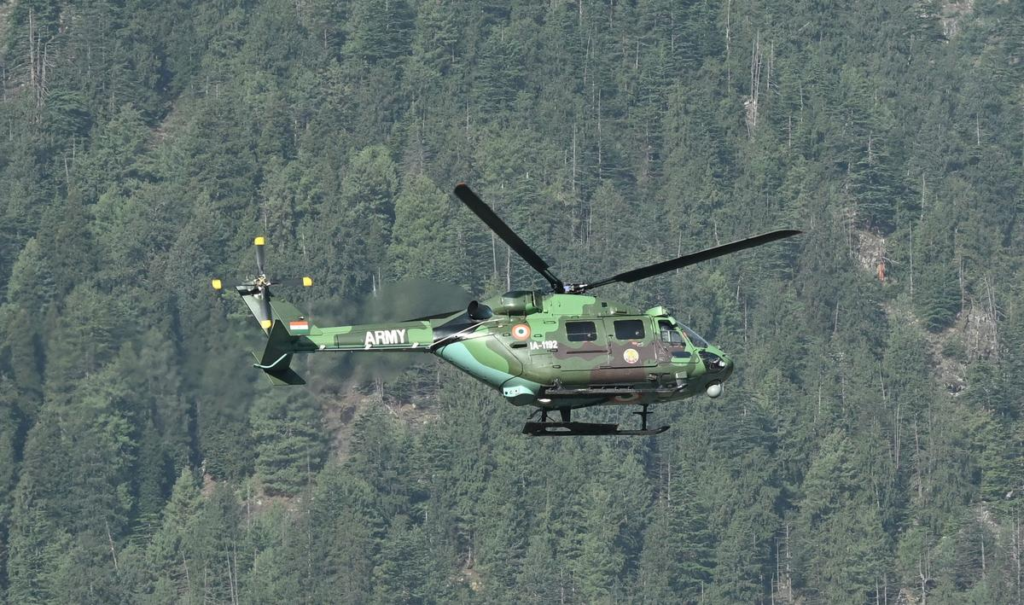On September 6, Hindustan Times carried an articles “New Glitch Plagues ALH Choppers” and “Safety Alarm Triggers Fresh ALH Fleet Check.” The piece painted a picture of India’s Advanced Light Helicopter (ALH) Dhruv as an unsafe and flawed platform, plagued by repeated glitches. However, a closer look reveals that the report either reflects a sheer lack of technical understanding or, worse, a deliberate attempt to malign one of India’s most successful indigenous aviation programs.

What HT Claimed
The report linked recent checks on the ALH fleet with earlier issues like the swashplate fracture that caused a Coast Guard crash in January. It emphasized the helicopter’s accident record, suggesting a design-level weakness in the platform. The narrative clubbed together older and newer issues, without differentiating between design flaws and maintenance-related events.
No doubt, the ALH has had its share of problems over the years, but most of these were maintenance-related and resolved through routine corrective measures, not design-level flaws as often misrepresented (deliberately or due to lack of understanding). In fact, HAL has consistently refined the platform by incorporating improvements and redesigning certain components, adding greater margins of safety to reduce maintenance sensitivities.
HAL’s Clarification: Maintenance, Not Design
Hindustan Aeronautics Limited (HAL), the maker of ALH, issued a strong rebuttal. The so-called “new glitch” is in fact a Tail Drive Shaft (TDS) issue, for which HAL and the Army have ordered a One-Time Check (OTC): A standard and routine maintenance directive, not an emergency design fix. HAL has also deputed expert teams to trace the root cause.
To put this in perspective, OTCs are common across global aviation industries whenever a defect is spotted. They do not imply a flawed design but are part of proactive fleet management.
ALH’s Proven Track Record
The HT report ignored the ALH’s proven history:
- Over 4.5 lakh flying hours logged across armed forces and civil operators.
- 20+ years of continuous service, operating in extreme conditions from Himalayan heights above 18,000 ft to hot coastal zones.
- Backbone of Army aviation, Navy’s utility missions, Coast Guard rescues, and Air Force operations.
- Actively deployed in flood relief and casualty evacuation, including recent high-risk rescues of stranded civilians and CRPF personnel.
Handful Apache vs Workhorse ALH
Helicopters are among the most complex flying machines, and even the most advanced platforms are not immune to technical snags. For instance, the Indian Air Force’s fleet of Apache attack helicopters has recorded at least four documented precautionary or emergency landings between 2023 and 2025. These included incidents in Bhind, Madhya Pradesh (May 2023), Ladakh (April 2024), Saharanpur, Uttar Pradesh (June 2025), and Pathankot, Punjab (June 2025). The Indian Air Force operates just 22 Apache attack helicopters, which by their role naturally fly fewer sorties than utility platforms like the ALH. Yet, between 2023 and 2025, there have been four documented precautionary or emergency landings.
Context Matters: Accidents vs. Operational Success
Every aircraft system worldwide faces accidents and technical directives. The UH-60 Black Hawk, Apache, or even Airbus civil helicopters have similar records of fleet-wide advisories and checks. Selectively highlighting accidents without mentioning the millions of successful sorties creates a skewed perception.
The Real Issue: Narrative vs. Facts
HAL’s response highlights the core problem: incomplete and selective reporting. By failing to separate design issues from maintenance aspects, the HT article created the impression of a systemic failure. This not only undermines public confidence but also casts doubt on the efforts of engineers, technicians, and operators who have kept ALHs flying safely for decades.
Overall, India’s ALH Dhruv is not without challenges, but its record speaks of a robust, battle-proven platform trusted by every branch of the armed forces. Media narratives that twist facts whether out of ignorance or intent do a disservice to national capability. As HAL rightly said, conclusions should be based on comprehensive data, not selective snapshots.